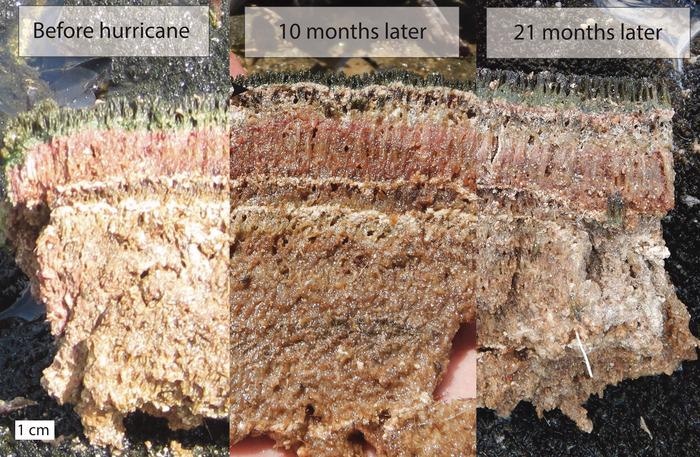Reviewed by Alex SmithMay 30 2022
Just a few months after sustaining catastrophic hurricane damage, a primordial groundcover crucial to supporting a multitude of coastal lifeforms bounced back to life.
 Photos taken before and after the hurricane demonstrates the resilience of the microbial mats. Image Credit: Johns Hopkins University.
Photos taken before and after the hurricane demonstrates the resilience of the microbial mats. Image Credit: Johns Hopkins University.
The finding, co-headed by a Johns Hopkins University geochemist and reported recently in the Science Advances journal, provides rare optimism for the fate of one of Earth’s most crucial ecosystems as climate change changes the global pattern of intense storms.
The good news is that in these types of environments, there are these mechanisms that can play an important role in stabilizing the ecosystem because they recover so quickly. What we saw is that they just started growing again and that means that as we continue to have more hurricanes because of climate change these ecosystems will be relatively resilient.
Maya Gomes, Assistant Professor, Earth and Planetary Sciences, Johns Hopkins University
The research team, co-headed by the California Institute of Technology and the University of Colorado, Boulder, had been learning about Little Ambergris Cay, an unoccupied island in Turks and Caicos, in particular, the island’s microbial mats.
Microbial mats are a spongey ecosystems that for eons have sustained a diverse array of life from the microscopic organisms that that make a home in the upper oxygenated layers to the mangroves it helps root and stabilize, which in turn provide habitats for even more species.
Globally, mats can be discovered in wildly diverse surroundings, but the variety this group studied is generally discovered in tropical, saltwater-oriented places. These are exactly the coastal locations that are highly vulnerable to severe storms.
In September 2017, the eyewall of Category 5 Hurricane Irma directly hit the island that the team had been working on.
Once we learned everyone was OK, we were uniquely well-poised to investigate how the mat communities responded to such a catastrophic disturbance.
Maya Gomes, Assistant Professor, Earth and Planetary Sciences, Johns Hopkins University
The tropical cyclone’s effect was instantly devastating, thereby choking the mats with a blanket of sandy sediment that destroyed new growth. But as the group checked on the site initially in March 2018, then again in July 2018 and June 2019, the researchers were excited to observe the mats regrowing. The new mats started to visibly sprout in just 10 months.
New mat growth advanced quickly and indicated that storm perturbation might streamline these ecosystems that have been adjusting to altering sea levels.
For islands and tropical locations with this type of geochemistry, Florida Keys would be one in the United States, this is sort of good news in that we think that the mangrove ecosystem as well as the microbial maps are pretty well stabilized and resilient.
Usha F. Lingappa, Study Lead Author and Postdoctoral Scholar, University of California
The research team included co-senior author Woodward W. Fischer., Nathaniel T. Stein, Kyle S. Metcalfe, Theodore M. Present, Victoria J. Orphan, and John P. Grotzinger, all of California Institute of Technology’s Division of Geological and Planetary Sciences; Andrew H. Knoll of Harvard University; and co-senior author Elizabeth J. Trower of the University of Colorado Boulder.
This study was financially supported by the Agouron Institute, NASA Research Opportunities in Space and Earth Science grant 80NSSC18K0278, and the NSF GRFP.
Journal Reference:
Lingappa, U. F., et al. (2022) Early impacts of climate change on a coastal marine microbial mat ecosystem. Science Advances. doi.org/10.1126/sciadv.abm7826.